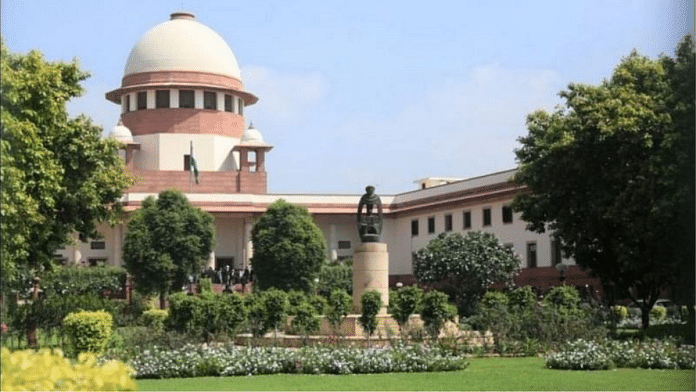New Delhi: A seven-judge Bench of the Supreme Court Tuesday began hearing a case which will decide whether “sub-classification” is permissible for scheduled castes (SCs) and scheduled tribes (STs).
The Bench, headed by Chief Justice of India D.Y. Chandrachud, is hearing an appeal against a decision of the Punjab and Haryana High Court which had set aside a 2005 Punjab law permitting sub-classification within the SC and ST categories.
“…let the remaining who are still backward within the backward, let them get the reservation. Once you achieve the concept of reservation, you should pull out of that reservation,” said the Bench, summarising Punjab’s arguments Tuesday.
The Bench added that children of reserved category Indian Administrative Service (IAS) and Indian Police Service (IPS) officers continue to avail reservation even if they do not face the disadvantages that are sought to be remedied.
“A person from a scheduled caste or scheduled tribe gets into IPS. So, once he is an IPS, IFS (Indian Foreign Service), his children don’t suffer the disadvantages that the persons from category who are residing in the villages suffer. But then by virtue of reservation, they are also entitled to get it (reservation), the second generation and again the third generation,” it observed verbally.
Justice Chandrachud also said that since our Constitution permits substantive equality and not formal equality, reservation is seen as a “furtherance” of the equality clause even though it may create differences within the backward and forward groups. It may then be permissible to create sub-classification, he said.
The case was referred to the seven-judge Bench by another five-judge bench of the court in 2020, which had expressed serious doubts about the correctness of the 2005 landmark judgment, E.V. Chinnaiah, which held that SCs were a “homogenous” group, and they could not be sub-classified under the constitutional scheme.
In 2006, the Punjab government passed a legislation which reintroduced “first preference” reservation for Balmiki and Mazhabi Sikhs, which would be offered before anyone else in the SC category.
The Punjab and Haryana HC then struck down this legislation in 2010, holding that such classification was not permissible according to the Chinnaiah decision. However, the Punjab government did not accept the decision and subsequently appealed to the apex court in 2014.
The matter was first listed before a three-judge bench of the SC in 2014, which had then referred it to a five-judge bench. However, in 2020, the five-judge bench had said that an even larger bench (of seven judges) was required to decide the dispute.
The Supreme Court will now decide whether the prohibition on sub-classification within the SC and ST categories is permissible and whether state governments can make sub-classifications within the SC community. ThePrint explains.
The Chinnaiah case
In the Chinnaiah case in 2005, the SC heard a challenge to an Andhra Pradesh law which divided existing SC reservation into distinct categories. While setting aside the reservation, the court said that SCs were a “homogenous” category and could not be subdivided, as it would lead to a violation of the right to equality.
“The whole basis of reservation is to provide additional protection to the members of the Scheduled Castes and Scheduled Tribes as a class of persons who have been suffering since a considerable length of time due to social and educational backwardness. The protection and reservation is afforded to a homogeneous group,” the court had then observed.
“By the impugned legislation, the State [of Andhra Pradesh] has sought to re-group the homogeneous group… It would tantamount to discrimination in reverse and would attract the wrath of Article 14 of the Constitution,” it had added.
It also said that state governments had no power to categorise people as SCs according to Article 341 of the Constitution.
Article 341 (1) provides powers to the President to categorise people as SCs for states, based on ‘consultation’ with the respective state governments.
‘Sub-classification permissible, should be referred to seven judges’
Before the court, Punjab contended that the SC decision which prohibited sub-classification within SCs did not recognise the Indra Sawhney case, which had explicitly recognised that some categories may be more backward than others. It also said that preferential treatment was a “facet” of the right to equality.
It also referred to a 2018 decision which had recognised the concept of “creamy layer” for SCs and said that such classification was explicitly permissible under Article 16 (4) of the Constitution.
Article 16 (4) enables the state to make provisions in favour of the backward class of citizens which are not adequately represented.
The court, in this case, had said that since the state had the power to grant reservation for SC and ST, it must also be competent to create sub-classification to further equality.
“In our opinion, it would be open to the State to provide on a rational basis the preferential treatment by fixing reasonable quotas out of reserved seats to ensure adequate representation in services,” the court had said.
“The constitutional goal of social transformation cannot be achieved without taking into account changing social realities,” it had added.
It reasoned that the sub-classification within SEBC categories, such as OBC, were permitted by the decision in Indra Sawhney, the SC and ST categories should not be treated differently when it came to sub-classification.
However, the court could not overrule the Chinnaiah decision as it was also a bench of five judges.
“We cannot revisit E.V. Chinnaiah being Bench of coordinate strength. We request the Hon’ble Chief Justice to place the matters before a Bench comprising of 7 Judges or more as considered appropriate,” the Bench had noted in 2020.
(Edited by Zinnia Ray Chaudhuri)
Also read: Abortion law in India is changing. Advocate Amit Mishra is at the centre of it all



